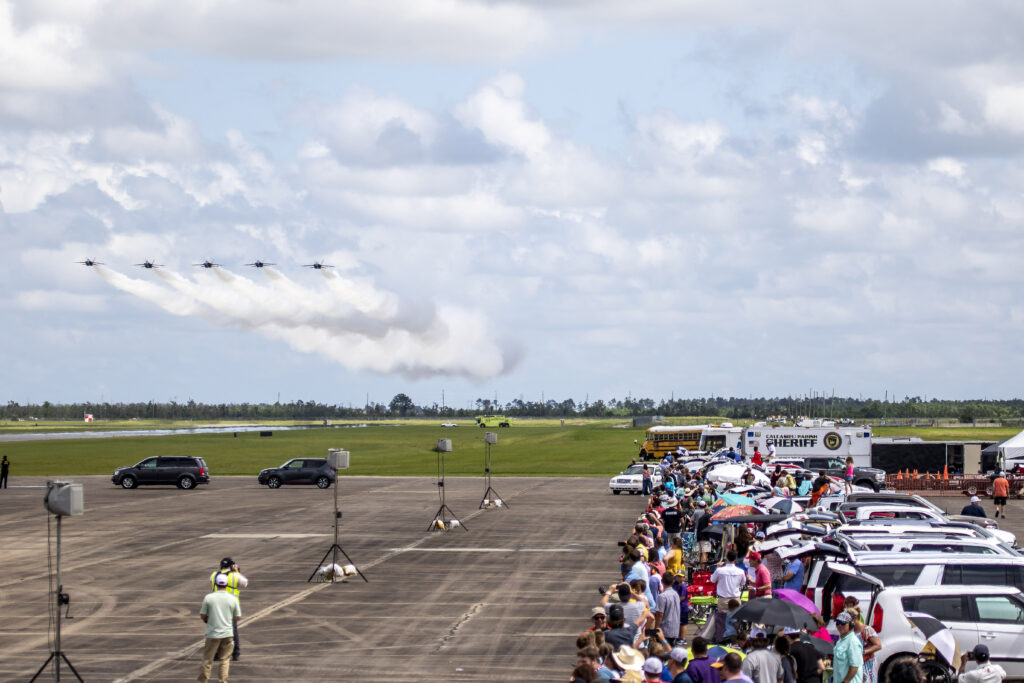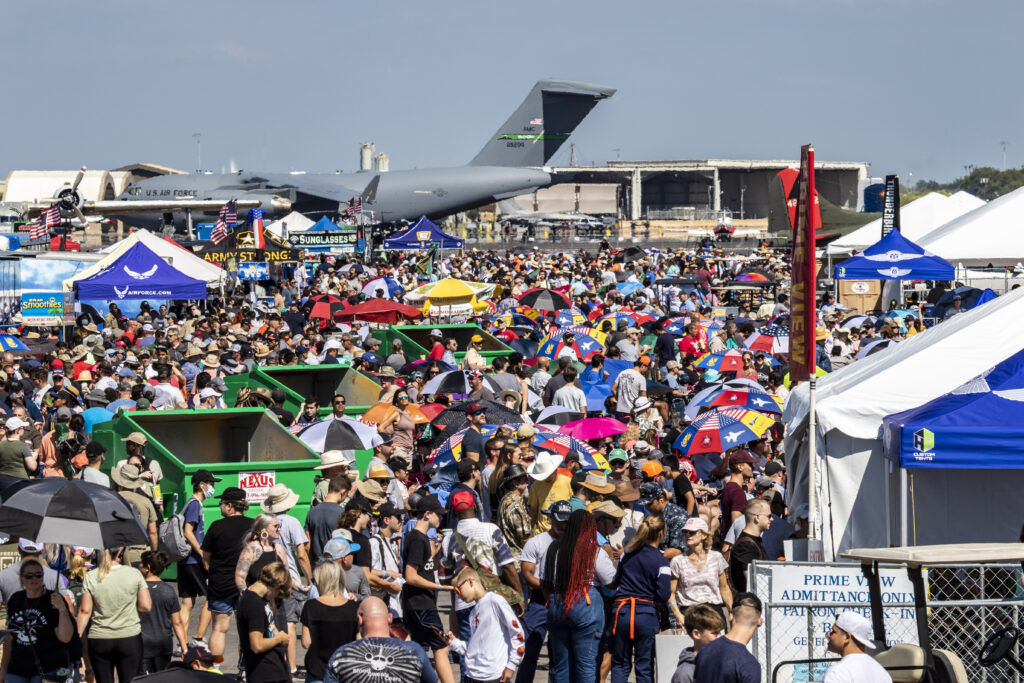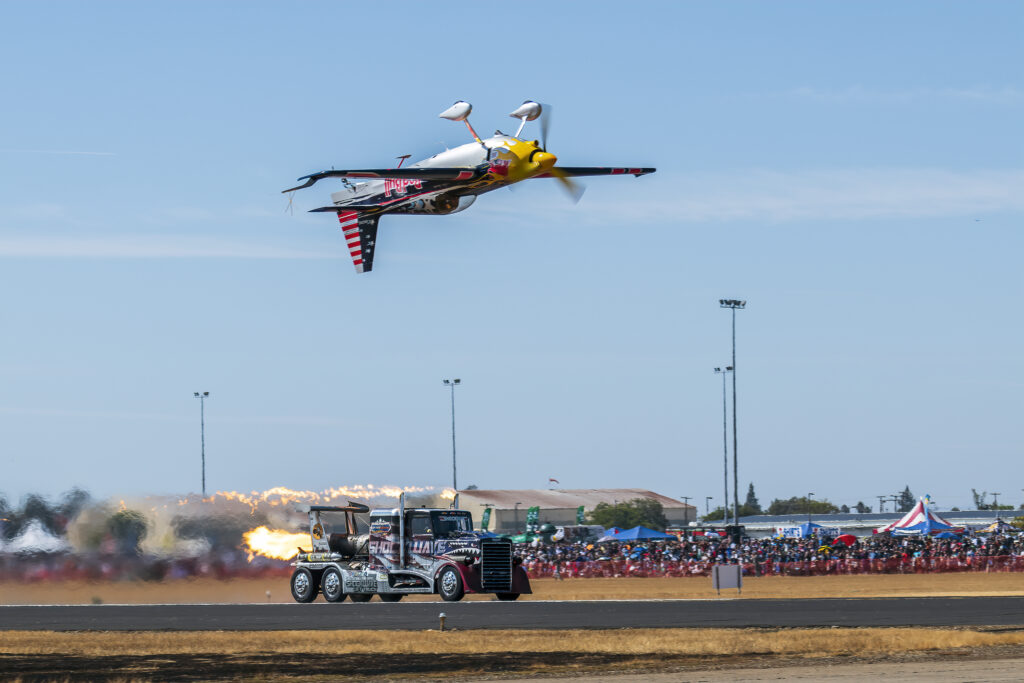Putting on a high-quality air show is a costly endeavor. Permits, performer costs, rentals, on-site vendors, and insurance costs can easily exceed tens — if not hundreds — of thousands of dollars. Add to that the ways unpredictable weather can wreak havoc on the event, and the financial stakes are high.
Over the years, “Raise your ticket prices,” has become a familiar refrain in the pages of this magazine, and with good reason.
“While the industry has made significant progress in recent years, most air shows are still pricing themselves well under the value that they are delivering,” said John Cudahy, president of ICAS. “One of the things that the pandemic has shown is that people are willing to pay more for the air show experience than we may have thought. A lot of air shows were forced to increase their prices in the last two years just to break even, but we’ve seen tremendous turnout from air show fans. Several of the air shows actually sold out, even with a higher price. Everyone in the industry should take note of that and consider how we can capitalize on it.”
In the past two decades, ticket prices have risen faster than the rate of inflation. In the early 2000s, the average price of a ticket was $8 at air shows that charged for individual admission. By 2008, it was $14. Just before the pandemic, the average price for a general admission ticket was $25. This may be due to a realization among some air shows that revenue from ticket sales is more reliable than in-kind and cash sponsorships of the event.
“Sponsorship is like a ninth-grade love affair,” said Kevin Walsh, event director for the Thunder Over Michigan Air Show, which doesn’t rely on sponsorship for funding. “It’s here today and gone tomorrow, and then back again a couple of days later. You just can’t rely on sponsorship. Any shift in economic climate, any shifting trends and consumer buying patterns, or a more aggressive event coming into town — it gets sucked away so quickly.”
Generating revenue from ticket sales is “the stronger play, and the safer play,” said John Haak, whose company EventSprout offers ticketing solutions for air shows and other events. “If an air show has two or three $100,000 sponsors, how many bad decisions does it take to lose $100,000? One.”
When air show attendees buy tickets, they aren’t doing so in a vacuum. Air shows are just one entertainment offering that people have to choose from. Consider the prices of other entertainment options competing for air show attendees’ patronage. According to SeatGeek, sports fans spend on average $48 for professional soccer tickets in the U.S., $53 for MLB tickets, $94 for NBA games, and more than $151 to attend a pro football game. Music concerts are costly as well, with prices starting in the teens for lawn seats at amphitheaters to well over $800 for floor tickets for top-name acts. Even something as commonplace as a movie on a Friday night can cost more than $20 for admission in some markets.

Also consider the frequency of these events. There are 81 home baseball games every year, and hockey and basketball each have 41 home games. In most communities, the air show happens once a year — and only once every two years in some places. Given the entertainment value that air shows offer, combined with their infrequency, most air shows have priced themselves well below the rate that air show fans will pay, and that may actually be detrimental.
“If you’re handed a wad of $5 tickets or $10 tickets, you may say, ‘OK, I mean, I might go or not go,’” said Wings Over Houston Airshow Executive Director Bill Roach. “If it’s a $35 or $40 ticket, that’s not pocket change.”
“Nobody wants to go to a $5 air show because they assume it can only offer a show that is worth $5,” said Haak. “Honestly, I’ve seen some of these shows as being as good as, or better than, shows that are $30 to $40. But they have that huge inferiority complex that no one will come if they charge that much.”
For these reasons and others, air shows near or under the industry average for ticket prices should consider increasing them.
“I have come to the conclusion that increasing ticket prices is the simple solution that it appears to be,” said Cudahy. “If you’re an event organizer and you want a particular performer and you just can’t afford them, that doesn’t mean that you just settle for something less than what you want. It means that the entertainment event you want to develop needs additional financial support.”
Make buying a ticket easy
Air shows need to make it simple for their patrons to purchase tickets. Today, that means selling tickets on a website that is easy to navigate on desktops and mobile devices, as well as reducing the number of clicks it takes a user to complete a purchase. If website visitors have to navigate through multiple pages to find the information they need to buy tickets, they may not actually follow through with the purchase. The more effort website visitors have to expend to purchase a ticket, the less likely it is that they will do so.
Moving ticket sales online also offers a number of benefits for air show producers. Attendees arrive with their ticket in hand, and air shows don’t have the hassle of securing, transporting, and counting large amounts of cash on site.
Online ticketing also makes it easier for air shows to collect information from their attendees. Emails can be used for communications about the upcoming show, to sell upgraded seats, or to better target-market future shows. That information can also be used to help land sponsors.
“Sponsors want to know the stats — who’s in the crowd, who are we talking to, how can we be more effective with our marketing while we’re involved in your show?” said Holly Doty, executive director Airshow London in Ontario, Canada. “That’s why it’s so important to us to understand who’s actually at the show so that we can tell it better to sponsors. Because if I can tell a company that of the 2,500 cars a day, 2,000 of them are families that are right in their target market, that’s an easy sell.”

Increase prices over time and offer discounts
Ticket prices don’t need to surge overnight. Air shows can gradually step up their ticket prices each year to stave off sticker shock. A price jump from $15 to $18 is easier to digest than an increase to $45.
When John Haak began working with one air show, tickets were being sold for $15. The revenue wasn’t enough to sustain the show. Haak’s advice to the organizer was, “Memorize this line: Get last year’s price this year in advance, $5 higher at the gate. Rinse and repeat every year.” Five years later, tickets were $40 and the event was a hit in the community.
Early-bird rates can also help sell tickets ahead of the show day and limit negative reactions to higher prices. When ticket prices are low and there isn’t a difference for non-refundable tickets purchased in advance compared to at-the-door prices, people are more likely to wait until the event comes around to purchase tickets. That’s why some air shows will offer tickets at as much as half off the gate price to those who are willing to purchase a non-refundable ticket months in advance. This allows shows to put money in the bank well before the show and helps organizers gauge how big a crowd to plan for.
Additionally, if people complain about high ticket prices, organizers can point to the discounted rates.
“We can justify [higher prices] because people have the opportunity to buy tickets as much as half off,” said Roach. “So if you didn’t jump at the chance, that’s your loss. That’s our fallback answer [when people complain] as well — you could have bought it back in June when it was half off.”
Offering early-bird rates can also reward loyal air show fans and help build email lists, which can then be used to communicate with attendees about upgraded seating options. Once people purchase general admission tickets to Thunder Over Michigan, Kevin Walsh begins marketing different options to enhance the attendees’ experience at the air show.
“I’m going to say, ‘Hey, thanks for being our ticketholders. Have you considered the Bomber Club or the Fighter Club or our Officer’s Club?’” he said. “Almost using these cheaper admission tickets as a gateway into an upgraded seating option.”
 Create a variety of premium seating options
Create a variety of premium seating options
When air shows conduct satisfaction surveys, one of the most consistent points of feedback is that people want more access to shade, water, and a place to sit.
“There’s a reason people are buying those reserved seats,” said Gary Bradshaw, owner of AttendStar, which provides ticketing services. “They want a better experience than just walking around on the ramp when it’s 90 degrees.”
While the majority of spectators will attend an air show on a general admission ticket, scores of people are looking for — and willing to pay more for — upgraded seating options, especially when it puts them closer to the action.
“The show is in the air, and all the spots are actually really good. But air show fans definitely feel that the closer they are, the better it is,” said Doty. “You can capitalize on that. That’s what they see as the sweet spot, and some of them are willing to pay good money to make that happen.”
When Airshow London pivoted to a drive-in format for its show during the pandemic, the parking section nearest the show line was priced higher than other parking selections.
In addition to front-row seating, there are a wide range of premium seating configurations that air shows can offer, from box seats or sectioned-off areas for photographers all the way up to fully catered, air-conditioned tents.
 While most air shows have a few different VIP experiences for spectators to choose from, Wings Over Houston offers more than a half-dozen VIP seating options that cater to different segments of their audience base. A general admission ticket is $50 at the gate. For $80, people can access a reserved seating area right on the fence line. Above this option, there is a photo pit for photographers, a family-friendly chalet, and another chalet with catering and drinks. At the top is an air-conditioned chalet with full bar, table service, meet and greets with performers, and other luxuries. Tickets are $450.
While most air shows have a few different VIP experiences for spectators to choose from, Wings Over Houston offers more than a half-dozen VIP seating options that cater to different segments of their audience base. A general admission ticket is $50 at the gate. For $80, people can access a reserved seating area right on the fence line. Above this option, there is a photo pit for photographers, a family-friendly chalet, and another chalet with catering and drinks. At the top is an air-conditioned chalet with full bar, table service, meet and greets with performers, and other luxuries. Tickets are $450.
Despite the relatively small number of people who will purchase VIP chalets, they can have an outsized impact on an air show’s bottom line. A 250-person VIP tent at $160 per ticket can bring in $40,000 in gross sales.
Make sure the air show delivers the value

Perhaps the single-most-important thing air shows can do when raising ticket prices is to make sure the product meets the consumers’ expectations. “If you’re going to charge a high ticket price, don’t give them seven acts of the same thing,” said Walsh. “You better have a darn good show to back up your ticket price.”
In addition to using new revenue to hire top-notch aerial entertainment, air shows can enhance the experience for their guests by creating backline entertainment offerings, like music performances, interactive STEM fairs, beer gardens, and more. And although less exciting than rock bands and formation aerobatic teams, air shows can improve their attendees’ experience with more mundane expenditures.
This can include things like ensuring washrooms are easily accessible, clean, and numerous; making sure there is adequate parking on site that’s efficiently managed; hiring a reliable sound contractor so that everyone can hear the show; and more.
Maintain perspective
No matter what air shows do, someone will always complain, and that’s no different when it comes to ticket prices. Air shows should keep complaints in perspective and focus on those who are actually purchasing tickets.
“Can they afford a $5 increase? Yes,” said Bradshaw. “People will complain about the price of the show, “and then the very next thing they do is head off to the local pizza restaurant and spend $60 on pizza, salads, and beer. That’s what people do. We’re human; we want it all for nothing.”
“I think that people need to stop listening to the complainers and start going after and start focusing solely on delivering an exceptional experience,” said Bradshaw.
It’s a sentiment that Kevin Walsh shares.
“The majority of your spectators have no idea what you’ve charged the year before,” he said. “So as ticket prices have gone up, there’s only one litmus test: Am I selling the same amount of tickets?”

The time to raise prices is now
As air shows move out of the era of pandemic restrictions, there is what may be a once-in-a-generation opportunity for shows to increase ticket prices. Consumers have been tolerant of changes to the air show experience and to price increases through the pandemic.
“Every show that I have talked to — and I have talked to more than 50 — did not see a drop in attendance when they increased their ticket prices,” said Cudahy. “Because of that, they were able to bank a hundred percent of that ticket price increase. If air shows can increase the revenue that they bring in each year, they will not only improve their own sustainability, also that of air show performers and vendors. This is going to be one of the most important things that we can do to make sure the next generation can still enjoy air show entertainment.”








